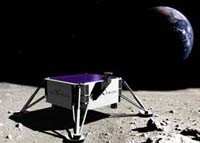'Next Giant Leap' Team Includes MicroSat Systems, MIT, Draper
Laboratory, Busek, And Aurora Flight Sciences
Next Giant Leap, a small company that was the fourth team to
register for the Google Lunar X Prize, publicly announced its name
and team members at a press conference held Thursday at the NASA
Ames Research Center. Based in the United States, the Next Giant
Leap (NGL) team boasts highly qualified members from the academic,
aerospace and small business communities.

NGL was founded on the concept that a small but focused team is
the ideal vehicle to efficiently engineer the winning Google Lunar
X Prize entry. Founded by entrepreneur Michael Joyce in November of
2007, the team was known only as the "Mystery Team" for the first
year.
"Our first year was well spent, recruiting the best possible
team members and building the strong working relationships required
to reach our goals," said Next Giant Leap Founder Michael Joyce.
"With the world class team we have assembled we are ready to take
the next giant leap forward required to win the Google X Prize and
establish NGL as a commercial lunar services company."
 The X Prize Foundation and Google Inc. announced the Google
Lunar X Prize, a robotic race to the Moon to win a remarkable $30
million prize purse, on September 13, 2007. Teams from around the
world are competing to land a privately funded robotic rover on the
Moon that is capable of completing several mission objectives,
including traveling at least 500 meters across the lunar surface
and sending video, images and data back to the Earth.
The X Prize Foundation and Google Inc. announced the Google
Lunar X Prize, a robotic race to the Moon to win a remarkable $30
million prize purse, on September 13, 2007. Teams from around the
world are competing to land a privately funded robotic rover on the
Moon that is capable of completing several mission objectives,
including traveling at least 500 meters across the lunar surface
and sending video, images and data back to the Earth.
"We've reveled in the additional excitement that has centered
around our 'Mystery Team' and are thrilled to have them finally
reveal their true identities," said Dr. Peter H. Diamandis,
Chairman and CEO of the X Prize Foundation. "We are delighted to
have them go public as we believe they will be a strong contender
with experienced participants, a strong academic partner and
several innovative, small space companies."
The lead systems integrator is MicroSat Systems, Inc., known for
its innovation in small spacecraft. On May 7, 2008, MicroSat
Systems was awarded a contract to build 18 Orbcomm Inc. satellites
with an option for 30 more.
In charge of the difficult task of landing safely on the Moon is
the Draper Laboratory. Draper has been involved in space guidance
navigation and control since the earliest days of the space program
supporting Apollo, the Space Shuttle and the International Space
Station.
The Department of Aeronautics and Astronautics at Massachusetts
Institute of Technology (MIT), the leading engineering institution
in the United States, is a key academic partner. The MIT team
includes five time Shuttle astronaut Jeff Hoffman and Professor
David Miller, head of MIT's Space Systems Laboratory and developer
of the innovative SPHERES (Synchronized Position Hold Engage and
Reorient Experimental Satellites) payload on the International
Space Station.
 "When approached to join the Next Giant Leap team, we thought
it was an outstanding opportunity for our students to be exposed to
several agile, cutting-edge companies in the space business while
working on a very challenging project," said MIT professor Jeff
Hoffman. "We feel that this team has the right stuff to have a shot
at capturing this very challenging prize."
"When approached to join the Next Giant Leap team, we thought
it was an outstanding opportunity for our students to be exposed to
several agile, cutting-edge companies in the space business while
working on a very challenging project," said MIT professor Jeff
Hoffman. "We feel that this team has the right stuff to have a shot
at capturing this very challenging prize."
Other innovative small companies that are partners on the team
include Aurora Flight Sciences, a company that operates on the
frontiers of flight with specialties in unmanned aerial vehicles
and manned space hardware, and Busek Co. Inc., a company that
specializes in advanced space propulsion, especially electrical
propulsion systems.
"It's an exciting time to see companies in the private sector
working to develop a vehicle that will land on the lunar surface,"
said NASA Ames Research Center Director S. Pete Worden. "These
competitions bring new and innovative ideas that everyone in the
space community can benefit from and that's a win-win for
everybody."
The $30 million prize purse is segmented into a $20 million
Grand Prize, a $5 million Second Prize and $5 million in bonus
prizes. To win the Grand Prize, a team must successfully soft land
a privately funded spacecraft on the Moon, rove on the lunar
surface for a minimum of 500 meters, and transmit a specific set of
video, images and data back to the Earth.
The Grand Prize is $20 million until December 31st 2012;
thereafter it will drop to $15 million until December 31st 2014 at
which point the competition will be terminated unless extended by
Google and the X Prize Foundation.
 Senator Pushes FAA to Accelerate Rocket Launch Licensing
Senator Pushes FAA to Accelerate Rocket Launch Licensing Classic Aero-TV: RJ Gritter - Part of Aviations Bright New Future
Classic Aero-TV: RJ Gritter - Part of Aviations Bright New Future Aero-FAQ: Dave Juwel's Aviation Marketing Stories -- ITBOA BNITBOB
Aero-FAQ: Dave Juwel's Aviation Marketing Stories -- ITBOA BNITBOB ANN's Daily Aero-Linx (10.27.24)
ANN's Daily Aero-Linx (10.27.24) ANN's Daily Aero-Term (10.27.24): Clearance Void If Not Off By (Time)
ANN's Daily Aero-Term (10.27.24): Clearance Void If Not Off By (Time)





